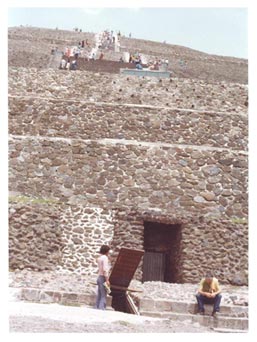
| FAMSI © 2007: Rebecca Sload |
||
Radiocarbon Dating of Teotihuacán Mapping Project TE28 Material from Cave under Pyramid of the Sun, Teotihuacán, México
Research Year: 2006 Table of Contents
Abstract This report analyzes 16 radiocarbon dates obtained from charcoal samples collected in 1978 by Teotihuacán Mapping Project (TMP) Test Excavation 28 (TE28) in the cave under the Pyramid of the Sun at Teotihuacán, Mexico. Questions relating to Teotihuacán use of the cave are explored–its earliest use, duration of use, dating of blockage construction and laying of the concrete floor, and whether there are any temporal differences between the front and rear sections of the cave. Studying the cave is important because its use was contemporaneous with the occurrence of political, social, and economic changes that defined the city until its fall 500–600 years later. It is likely that these changes had an ideational component that was linked to the Pyramid and cave. Based upon the results of the 16 radiocarbon dates, I suggest the following. It seems as if the entirety of the cave as we see it today was in use by around the middle of the first century CE. This dating agrees well with the ceramics. The radiocarbon dates fall squarely in the Tzacualli phase, which is the earliest ceramic phase represented by TE28 ceramics. It seems as if the laying of the concrete floor in the entirety of the cave, as well as the construction of the blockages, occurred within a fairly compressed period of time, probably around the middle of the third century CE. This time frame is surprising, because it is solidly in the middle of the Early Tlamimilolpa phase, a ceramic phase that is sparsely represented in cave ceramics. In addition, access to the cave may have been stringently controlled. Data suggest that the cave was used by very limited numbers of people, acting extremely reverentially. It also appears as if the cave experienced a significant period of disuse prior to its being encased in concrete and blocked off. While 16 dates are too few to express these finding with a high degree of confidence, the dates are consistent and provide an important part of the comprehensive publication of the cave that is in progress. Click to download the report in PDF format: The PDF files require Adobe Acrobat Reader.
Submitted 04/17/2007 by: |
||
|
Text links to all pages at this site are available at the FAMSI INDEX |
||

